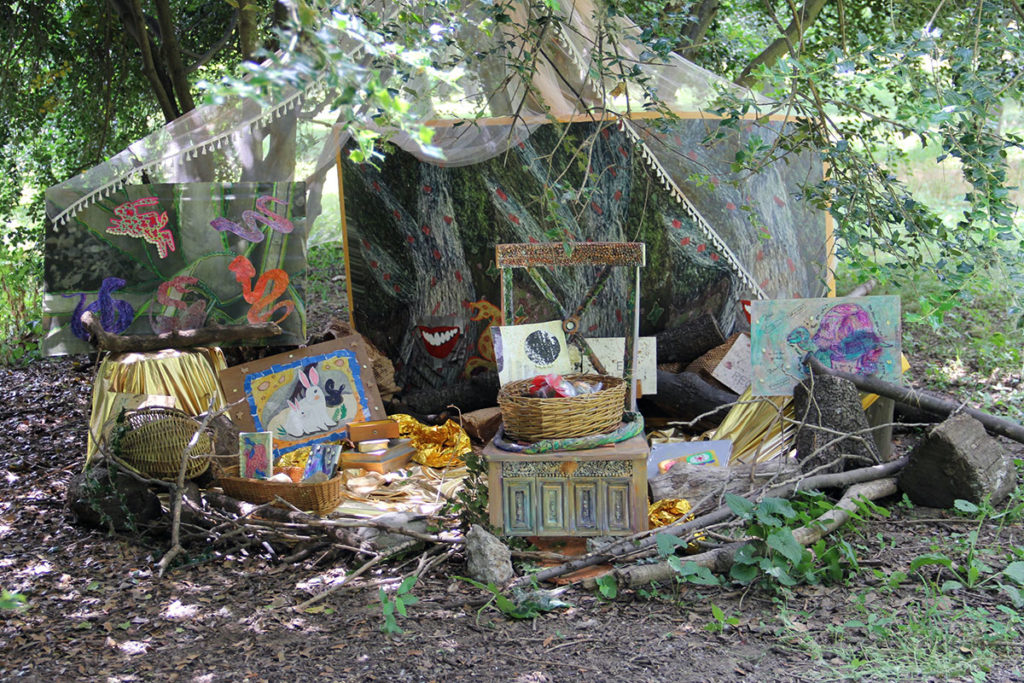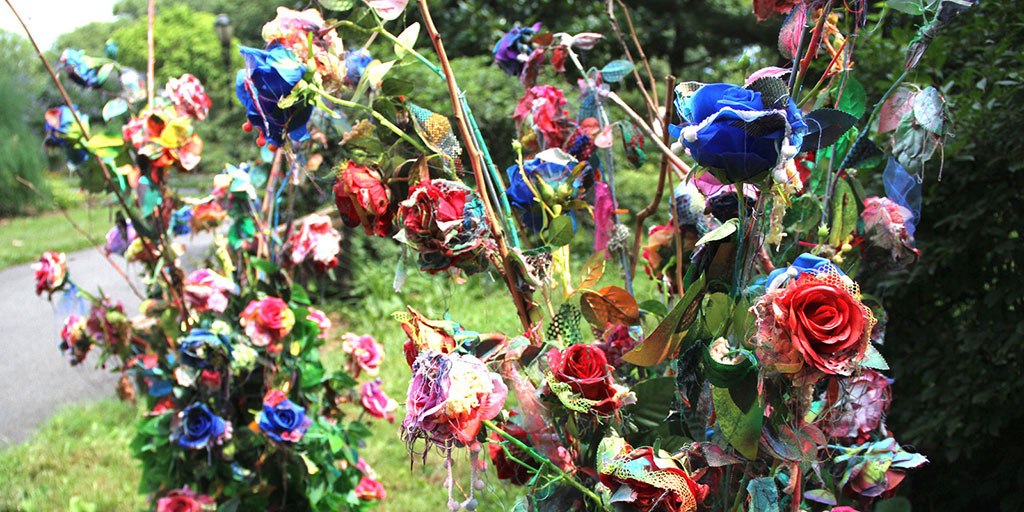Argentine, Brazilian and Salvadoran -American artists have Ankhlave Arts Alliance garden installations at the Queens Botanical Garden in Flushing, Queens; Tuesday-Sunday through September 8, 2020. $6
The six artists are women. Two are Japanese Americans. There are many important Japanese heritage communities in Latin America. It’s all good. We are one.
Latin American Art Has It’s Own Context
This is not traditional art like you’ll find in a gallery. You can’t look at Latin American art with European eyes. They are completely different world views. But this work is very thoughtful and deep really. In the tradition of female Latin American artists, much of the work speaks to social issues. It’s also very interactive. It interacts with the garden as you interact with it.
Artists are compelled to make art no matter what is going on. These artists are responding to the fear, isolation and intense emotions of Covid-19 quarantine and the decolonization process that we are going through now.
Ankhlave Arts Alliance
AnkhLave Arts Alliance produces contemporary art by people of color. The Executive Director Dario Mohr has produced really interesting videos of the artists explaining their work. It’s worth watching these videos before you visit the garden. queensbotanical.org
The artists are:
- Natali-Bravo Barbee (Argentina): “Femicide Flower”, Media Cyanotype on watercolor paper, glue, twine and platter. Instagram @barbee_bravo
- Cecilia Andre (Brazil) “Rainbow Squared”, Breaking Waves & BlossomTransparent Vinyl Stitched on Fabric. Instagram @cicaandre
- Mariana Tonini Vilas Boas (Brazil) “Marielle Franco Presente!”, Acrylic on canvas, wood branches and rope. Instagram @mari.artovibo
- Christine Sloan Stoddard (El Salvador) “Rabbit’s Storytelling Throne”,On-site Installation. Instagram @artistchristinestoddard
- Asano Agarie Gomez (Japan) “Rosie”. Instagram @asano.a.g
- Kayo Shido (Japan) “Dry Garden”. @kayoshidoart
We are interested heritage, but it has to be said that these are all Americans.
Rabbit’s Storytelling Throne

All the work is interesting, but we were immediately drawn to Christine Sloan Stoddard’s “Rabbit’s Storytelling Throne.” She is creating at a subconscious level.
At a glance, you might think it’s not art. It looks like a homeless encampment. Maybe that is part of what Sloan Stoddard is saying, that our home life has been disrupted. We are emotionally homeless.
We were attracted by “rabbit” as a West African storytelling character. Br’er Rabbit which you may know as a children’s story in the American South, is from this line. He is a trickster character whose original source is the Orisha of the crossroads Eleguá/Eshú who we know very well in Africa, the Caribbean and Latin America.
The installation also reminded us of Orisha shrines in West Africa and Central Africa.
The use of found objects in New York City are art historical references to Marcel Duchamp and Robert Rauschenberg. Duchamp displayed his infamous “Fountain” (1917) at The Grand Central Palace in New York City. People said it wasn’t art. 🥺
Rauschenberg had a studio in Downtown Manhattan and used to pick up trash left on the street from renovations. We wonder what the story is behind the goat in his famous “Monogram” (1955-59). Only in New York City.
Pre-literate traditional cultures tell their stories through symbols. The throne symbolizes status and control. The changes we are going through have been dominating our lives.
There is the tortoise and the hare. We know who won that story and right now New York City is winning that story.
None of these points of view are Sloan Stoddard’s context. She relates the installation back to very personal stories from her childhood. If you watch her video, you might recognize some of your own experience in hers.
Symbols of childhood represent optimism and hope, the natural state of humanity, and the natural state of New Yorkers. We bitch and moan with the best, but true New Yorkers always believe that we and our city have bright future.
From a Valley of Ashes a Garden Grows
In a way, Sloan Stoddard’s installation represents the rebirth of the Queens Botanical Garden, first from the 1964 World’s Fair, and before that from the garden of ashes that was the Corona Dump.
This is a valley of ashes – a fantastic farm where ashes grow like wheat into ridges and hills and grotesque gardens; where ashes take the forms of houses and chimneys and rising smoke and, finally, with a transcendent effort, of men who move dimly and already crumbling through the powdery air.”
“The Great Gatsby,” F. Scott Fitzgerald, 1925
We can’t wait to see what grows in our city when the powdery air is again safe for all of us to breathe. The only certainty we know is that something beautiful will grow and that the 2020 Ankhlave Garden Fellows will have been a small, but wonderful part of it.
Have a look at the artist’s statement videos, and go see the installations at the Queens Botanical Garden. You’ll be glad you did.
Walking in the garden and visiting these installations is literally a breath of fresh air.

